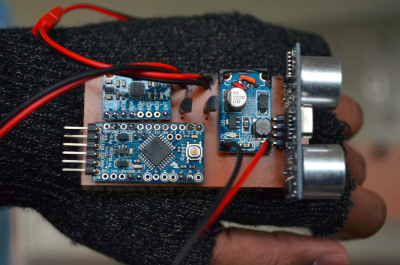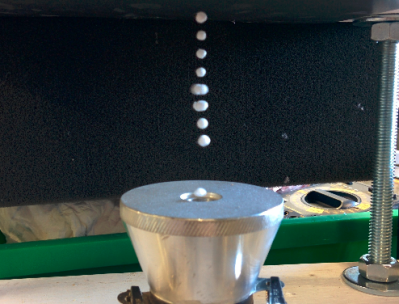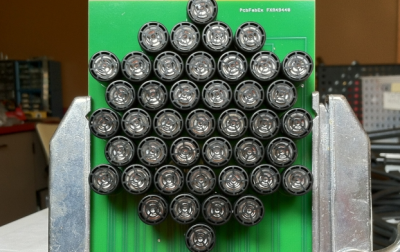Ultrasound refers to any audio signal above the range of human hearing. Generally that’s accepted as 20 kHz and up. Unlike electromagnetic signals, ultrasonics are still operating in a medium – generally the air around us. Plenty of animals take advantage of ultrasonics every day. So do hackers, makers, and engineers who have built thousands of projects based upon these high frequency signals. This weeks Hacklet is all about the best ultrasonic projects on Hackaday.io!
 We start with [spambake] and World’s Smallest Bat Detector. [Spambake] is interested in bats. These amazing creatures have poor eyesight, but that doesn’t slow them down. Bats use echolocation to determine their surroundings. Ultrasonic chirps bounce off obstacles. The bat listens to the echos and changes its flight path accordingly. While we can’t hear most of the sounds bats make, electronics can. [Spambake] cooked this circuit up starting with a MEMs microphone. These microphones pick up human sounds, but unlike our ears, they can hear plenty above the 20 kHz range. The audio signal is passed through an amplifier which boosts the it up around 10,000 times. The signal is filtered and then used to trigger LEDs that indicate a bat is present. The final circuit works quite well! Check out [spambake’s] video to see the bat detector in action!
We start with [spambake] and World’s Smallest Bat Detector. [Spambake] is interested in bats. These amazing creatures have poor eyesight, but that doesn’t slow them down. Bats use echolocation to determine their surroundings. Ultrasonic chirps bounce off obstacles. The bat listens to the echos and changes its flight path accordingly. While we can’t hear most of the sounds bats make, electronics can. [Spambake] cooked this circuit up starting with a MEMs microphone. These microphones pick up human sounds, but unlike our ears, they can hear plenty above the 20 kHz range. The audio signal is passed through an amplifier which boosts the it up around 10,000 times. The signal is filtered and then used to trigger LEDs that indicate a bat is present. The final circuit works quite well! Check out [spambake’s] video to see the bat detector in action!
 Next up is [Neil Movva] with Pathfinder – Haptic Navigation. Pathfinder uses ultrasonic transducers to perform echolocation similar to bats. The received data is then passed on to a human wearer. [Neil’s] idea is to use Pathfinder to help the visually disabled and blind navigate the world around them. Pathfinder was a 2015 Hackaday Prize finalist. The ultrasonic portion of Pathfinder uses the ubiquitous HC-SR04 distance sensor, which can be found for as little as $2 USD on eBay and Alibaba. These sensors send out a 60 kHz signal and listen for the echos. A microcontroller can then measure the time delay and determine the distance from the sensor to an obstacle. Finally the data is passed on to the user by a vibrating pager motor. [Neal] was kind enough to give a talk about Pathfinder at the 2015 Hackaday SuperCon.
Next up is [Neil Movva] with Pathfinder – Haptic Navigation. Pathfinder uses ultrasonic transducers to perform echolocation similar to bats. The received data is then passed on to a human wearer. [Neil’s] idea is to use Pathfinder to help the visually disabled and blind navigate the world around them. Pathfinder was a 2015 Hackaday Prize finalist. The ultrasonic portion of Pathfinder uses the ubiquitous HC-SR04 distance sensor, which can be found for as little as $2 USD on eBay and Alibaba. These sensors send out a 60 kHz signal and listen for the echos. A microcontroller can then measure the time delay and determine the distance from the sensor to an obstacle. Finally the data is passed on to the user by a vibrating pager motor. [Neal] was kind enough to give a talk about Pathfinder at the 2015 Hackaday SuperCon.
 [HoboMunching] likes his ultrasonic devices ultra powerful, and that’s just what he’s got with Ultrasonic Levitation Rig. Inspired by a similar project from Mike, [HoboMunching] had to build his own levitation setup. Ultrasonic levitation used to be a phenomenon studied only in the laboratory. Cheap transducers designed for the industrial world have made this experiment practical for the home hackers. [HoboMunching] was able to use his rig to levitate up to 8 tiny balls on the nulls between the 28.5 kHz sound waves produced by his transducer. The speed of sound can be verified by measuring the distance between the balls. Purists will be happy to hear that [HoboMunching]’s circuit was all based upon the classic 555 timer.
[HoboMunching] likes his ultrasonic devices ultra powerful, and that’s just what he’s got with Ultrasonic Levitation Rig. Inspired by a similar project from Mike, [HoboMunching] had to build his own levitation setup. Ultrasonic levitation used to be a phenomenon studied only in the laboratory. Cheap transducers designed for the industrial world have made this experiment practical for the home hackers. [HoboMunching] was able to use his rig to levitate up to 8 tiny balls on the nulls between the 28.5 kHz sound waves produced by his transducer. The speed of sound can be verified by measuring the distance between the balls. Purists will be happy to hear that [HoboMunching]’s circuit was all based upon the classic 555 timer.
 Finally we have [Alan Green] with Ultrasonic Directional Speaker V1. Most audio signals are not very directional, due to wavelength and practical limitations on speaker size. Ultrasonics don’t have this limitation. Couple this with the fact that ultrasonic signals can be made to demodulate in air, and you have the basis for a highly directional speaker setup. “Sound lasers” based on this system have been around for years, used in everything from targeted advertising to defensive weapons. [Alan] is just getting started on this project. Much of his research is based upon [Joe Pompei’s] work at the MIT media lab. [Alan] plans to use an array of ultrasonic transducers to produce a directional signal which will then demodulate and be heard by a human. This project has a hard deadline though: [Alan] plans to help his son [Mitchell] with a musical performance that is scheduled for May, 2016. The pair hope to have a prototype in place by March.
Finally we have [Alan Green] with Ultrasonic Directional Speaker V1. Most audio signals are not very directional, due to wavelength and practical limitations on speaker size. Ultrasonics don’t have this limitation. Couple this with the fact that ultrasonic signals can be made to demodulate in air, and you have the basis for a highly directional speaker setup. “Sound lasers” based on this system have been around for years, used in everything from targeted advertising to defensive weapons. [Alan] is just getting started on this project. Much of his research is based upon [Joe Pompei’s] work at the MIT media lab. [Alan] plans to use an array of ultrasonic transducers to produce a directional signal which will then demodulate and be heard by a human. This project has a hard deadline though: [Alan] plans to help his son [Mitchell] with a musical performance that is scheduled for May, 2016. The pair hope to have a prototype in place by March.
If you want to see more ultrasonic projects, check out our new ultrasonic projects list! If I missed your project, don’t be shy! Just drop me a message on Hackaday.io. That’s it for this week’s Hacklet. As always, see you next week. Same hack time, same hack channel, bringing you the best of Hackaday.io!















Could a terahertz Free-Electron Laser, operating at a roughly similar wavelength as ultrasound in air, be used to levitate submillimeter objects? Does laser diamagnetic levitation exist?
Try these
https://www.google.co.uk/search?q=laser+diamagnetic+levitation+exist%3F&ie=utf-8&oe=utf-8&gws_rd=cr&ei=Kp6aVvjFOInSUf2fpfAK
The radiation force on an absorbing or reflecting object is proportional to the beam power density divided by the speed of propagation.
E-M radiation (light, radio, terahertz, x-rays, etc) has a propagation speed almost a million times greater than sound in air, so the power density incident on a levitating object will be a million times greater too.
Acoustic power densities involved here are already extremely high. It’s damned unlikely you can levitate something on an E-M beam and not promptly vaporize it.
Ah, blast: for the physics nit-pickers, the radiation force is proportional to the beam *power*. The radiation *pressure* is proportional to the beam power *density*.
Hmm… My idea for an experiment was to include the object to be levitated inside an optic cavity, so that the optic field is a standing wave instead of a traveling wave. I’m not sure if this makes a difference.
The object’s surface is small compared to its volume (it’s a small object), so its heat capacity would be low and black body radiation proportionally high. THz radiation passes through most non-metal, non-liquids with little absorption, so with the right material vaporization might not take place…
The problem that using lasers instead of ultrasound would solve is ultrasound’s heterodyning to audible frequencies. – A creature comfort.
these hacklets would be so much better if you did not limit yourselves to projects on hackaday.io.
That is the point though. Just be glad that they’ve gotten past the whole “clocks that look like bombs” meme.
Anyone here fiddled with ultrasonic dog repellers? I have seen commercial ones work but my prototype (555 + push pull transistors driving a piezo with 30V, sweepable from 19-40 kHz) has so far produced no results… Dogs turn to look at me then yawn or just stare at me…
i don’t know about your built, but I have seen dogs standing near repellents quite a lot of times.
I’m dubious about those repellers, unless they are very loud (100+ db) most dogs would probably just ignore it like we ignore noise.
Well, my experience is with a friends (domesticated) dog that ran as soon as my friend pushed the button (and it was not abused so as to fear that sound). The device had a piezo disk (90% sure). Anyway I might try it with a loud tweeter but then I would need a different amplification method and lower voltage, higher current, which I was trying to avoid…
Yes. The first thing to understand is that the amount of power required to actually cause pain is excessive. Even at one meter, it’s difficult producing pain with a single piezo driven to its limits.
So from the dog’s point of view, it’s just an unusual sound, not even particularly annoying as one might assume. And the response is entirely dependent on the dog. Some may stop and puzzle over it, which is useful if you’re on a bike and being chased. Others will ignore it completely. A minority will innately fear it, and run, though a few true nutcases will attack the source (which it may perceive as you rather than the device). You can demonstrate that a commercial device works to produce the desired effect, if demonstrated on the right dog; but it will not have consistent results given a random dog.
You could, however, train virtually any dog to fear the sound. It will have to associate the sound with something else, that is actually painful, or it doesn’t like and prefers to avoid. I’ve been forced to do this with a nuisance barking case, since all other remedies failed. The dog learned quickly. Within two weeks and after just a few corrections, only the sound was necessary. And after two months, the training was 100% effective and permanent.
Do not cross the line into animal cruelty. Some have a very weird view of what constitutes cruelty, so I’ll omit the exact details of what the initial supplemental correction was. I’ll say that I took great care to cause only brief pain, only what was necessary for training, and *never* injury. This took some training on my part, and much practice on inanimate objects (occasionally excluding myself), until I was confident I could always produce the intended effect, no less and no more. Anyone attempting this should do the same.
Thanks for the in depth reply!
I am against needless violence as well so that is why I wanted to muck around with ultrasounds. The thing is that I just want to be able to drive some strays away from places they shouldn’t be (so no training involved).
As for the pain part, I don’t think these things cause the dogs pain; I always imagined it is like someone coming near you and playing “music” that you dislike, loudly so you leave…
I’d initially imagined the same. But we seem to be unique as a species in how we react to music and other sounds. Dogs for the most part just don’t care, unless the sound actually means something to them. Otherwise the sound is ignored, even if very loud.
Perhaps you may still find a solution that both works and doesn’t require compromising morals, but it will take some experimentation, effort, and expense.
Using a motion sensor to play the sound of a large dog growling, or a rattlesnake, may trigger an instinctual response. (I used this to train a cat to keep off my keyboard, the sound used was a sudden blast of harmonica; I don’t know why, but that was by far the most effective, even more than cat hisses/growls.) With a motion sensor in place, you might also spray a mist of commercial dog repellent, or white ammonia diluted to the point where it won’t cause nitrogen burns to vegetation.
Another training method I’ve used is putting a static charge on objects, via an ionizer module. The object must be insulated from ground, and at least somewhat conductive (plants work). It must also have capacitance at the target voltage to build up a “wool socks rubbed on carpet then touch a doorknob on a dry day” zap. Yet not be capable of storing enough charge to be dangerous (no Leyden jars). The continuous output from the ionizer isn’t enough to cause harm. A neighbor complained their Doberman was tearing apart their Christmas tree, and they couldn’t find a way to make it stop; manual corrections and scent- or taste-based repellents had failed. I installed an ionizer on it for them, and the Doberman quickly left the tree alone.
how?
No DIY cross-path US anemometers?
http://hackaday.com/2013/08/21/ultrasonic-anemometer-for-an-absurdly-accurate-weather-station/
They could have but then you would have cried repost
Hey Adam, thanks for leaving out Grindhouse Wetware’s Bottlenose Dolphin.
Regarding the Ultrasonic Directional Speaker:
If I remember correctly, Pompei avoided traditional piezos because the active element is crystalline and rigid. They’re easily cracked or damaged by the power levels required. Some are weaker than others and will eventually give out even if operated within what’s considered a safe margin; and a damaged piezo may produce horrible audible noises as the fractured elements make or break contact. The likelihood of this happening increases with the number of transducers, ultimately limiting the size and reliability.
Electrostatic speakers were also tried, and while effective and reliable, they require high voltage and complex drive circuitry. (However, I wonder if this could now be simplified by the use of piezoelectric transformers to generate the high voltage.)
Piezoelectric film is more resilient than crystalline piezos, and is what he settled on. It requires a higher voltage, but not nearly as high as electrostatics. As far as I know, there is no source of this film that sells small quantities at a reasonable price. I have seen some relatively cheap Chinese speakers based on piezo film, but whether the film used is of high enough quality to produce ultrasonics at the required power, I do not know.
Also, I noticed a highly directional speaker in WalMart recently, placed over a particular aisle in health and beauty, and playing advertisements particular to the products on that aisle. It was clearly audible over that aisle, but very faint on the next aisle, and completely inaudible beyond that. I don’t know if it’s based on ultrasonics, but if so, it’s the first application of this tech I’ve personally encountered. I’m sure there will be more to come shortly, for better or worse.
I forgot… Anyone have a free link for the Elektor article, “Ultrasonic Directive Speaker”, as referenced by the ultrasonic hacklet? It’s behind a paywall. If I intended to build one, 19 euros would be no problem, but that’s a bit much for general curiosity.
this one? http://mail.blockyourid.com/~gbpprorg/mil/speechjam/Ultrasonic_Directive_Speaker.pdf
Just in case it doesn’t occur to someone to back up a little bit in that URL, here’s something that will ruin your day or possibly your life.
http://mail.blockyourid.com/~gbpprorg/mil/
its the first link coming out in google for ‘elektor ultrasonic speaker’ ….. did not check what is the rest available on the website.
Thanks Bogdan!
I opened it in a virtual machine just to be sure, but I recognized that name as “GBPRR Projects”, which is a website I’ve visited some years in the past. It’s full of controversial tech and weapons, anarchy, supposed black military projects, pseudoscience, mind control and conspiracy theories, and general paranoia. The latter explaining why they’re running on such a domain, rather than malicious intent. It’s safe AFAIK, the only filter needed is critical thinking, and if one doesn’t mind digging through the nonsense, there are some genuinely interesting projects.
A lot of that stuff is really outdated, but neat anyway.
There are a depressingly large number of YT videos linking ultrasonics to mind control.
Love the batdetector. My son would love something like this!
I know where I can get one of those directional speaker setups as a kit here in Akihabara. Uses the same accoustic drivers too.
I have often thought of purchasing one to play with, but the ¥10000 price tag puts it just out of reach of an impulse buy…